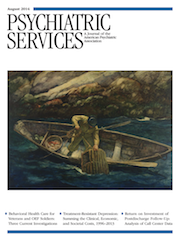A Review of the Clinical, Economic, and Societal Burden of Treatment-Resistant Depression: 1996–2013
Abstract
Objective
This literature review assessed the burden of treatment-resistant depression in the United States by compiling published data about the clinical, societal, and economic outcomes associated with failure to respond to one or more adequate trials of drug therapy.
Methods
PubMed and the Tufts Cost-Effectiveness Analyses Registry were searched for English-language articles published between January 1996 and August 2013 that collected primary data about treatment-resistant depression. Two researchers independently assessed study quality and extracted data.
Results
Sixty-two articles were included (N=59,462 patients). Patients with treatment-resistant depression had 3.8±2.1 prior depressive episodes and illness duration of 4.4±3.3 years and had completed 4.7±2.7 unsuccessful drug trials involving 2.1±.3 drug classes. Response rates for treatment-resistant depression were 36%±1%. A total of 17%±6% of patients had prior suicide attempts (1.1±.2 attempts per patient). Quality-of-life scores (scale of 0–1, with 0 indicating death and 1 indicating perfect health) for patients with treatment-resistant depression were .41±.8 and .26±.8 points lower, respectively, than for patients who experienced remission or response. Annual costs for health care and lost productivity were $5,481 and $4,048 higher, respectively, for patients with treatment-resistant versus treatment-responsive depression.
Conclusions
Treatment-resistant depression exacts a substantial toll on patients’ quality of life. At current rates of 12%–20% among all depressed patients, treatment-resistant depression may present an annual added societal cost of $29–$48 billion, pushing up the total societal costs of major depression by as much as $106–$118 billion. These findings underscore the need for research on the mechanisms of depression, new therapeutic targets, existing and new treatment combinations, and tests to improve the efficacy of and adherence to treatments for treatment-resistant depression.



